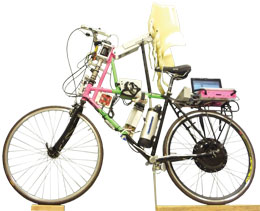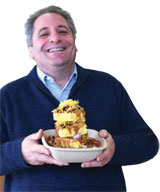Volume 29 · Number 4 · Summer 2012
End Notes

A bicycle, outfitted with sensors, measures the dynamics of both the bike and its rider.
Hip-hop science
Riding bikes, playing basketball and throwing a Frisbee are serious subjects of study at the Sports Biomechanics Laboratory. But the research is still fun, says Jake Setterbo, Ph.D. '11 — so much fun that he created a song and two videos, This is Why We Stay in School and This is Why We Stay In School 2 (Sports Biomechanics Version).
He posted the videos on YouTube to show kids some of the rewards of learning math and science. "Well, we've done some research, and we think it's cool, and these are some of the reasons why we stay in school," the rap song begins in the second video. "This is the laboratory of sports biomechanics, where we test a sport to better understand it."
The video was filmed in the lab with graduate students Jason Moore, Luke Peterson, Thomas Johnson, Gilbert Gede and Andrew Kickertz. It also features Professor Mont Hubbard, one of Setterbo's advisers, lip-synching from his seat in a virtual reality bobsled simulator, shooting hoops, dancing and riding a scooter.
Setterbo's first Stay in School video explains in rhyme his doctoral research on which type of racetrack surface is least strenuous to horses.
He came up with the song idea during a bike ride home from the laboratory while he was a biomedical engineering doctoral student.
Setterbo enlisted fifth-graders then taught by his wife, Jennifer, at Anna Kyle Elementary School in Fairfield to sing backup: "This is why we stay in school. Because it's cool."
"Nowadays, engineering and science degrees are more difficult than other degrees," said Setterbo, who now is director of grants for a consulting company in Houston. "Sometimes students need more encouragement to pursue those degrees. In high school, I knew about math and science, but didn't know much about engineering. I want to help expose kids to things I didn't know about."
— Elizabeth Stitt '11
Space rocks

The minivan-sized meteorite that broke up over the Sierra in April was not just any old space rock. It was one of the rarest types of meteorites to fall to Earth — a carbonaceous chondrite, the earliest solid material to form in our solar system more than 4.5 billion years ago, before the planets, including Earth, formed.
If its age and identity are confirmed, this meteorite could turn out to be one of the most scientifically important to fall to Earth since the late 1960s, says UC Davis geology associate professor Qing-zhu Yin. Which explains why Yin's out-of-office email recently read, "Gone meteorite hunting."
Yin's lab at UC Davis is one of a few in the country with the equipment to analyze and accurately date the meteorite, which may contain carbon, water and even simple sugars — the basis of life. He hoped to collect as many fragments as possible for scientific analysis.
— Andy Fell
Take the Quad Stack challenge
It's called the Quad Stack, and it's almost as big as the nearby Quad.
Weighing in at 2 pounds, the Quad Stack is the largest version of the Chili Stack at the CoHo South Café in the new Student Community Center. The Coffee House branched out there in February.

Mitchel Benson:"It's an architectural and gastronomical wonder."
"We wanted a signature dish, something unique for our new café," said Darin Schluep, food service manager for the Coffee House.
The stack features two, three or four layers of cornbread smothered by vegetarian, four-bean chili, with cheese and onions on top.
Longtime CoHo Director Sharon Coulson came up with the idea, inspired by a dish her mother used to make: chili and cornbread pancakes. Her brothers stacked them high — inspiring the Quad Stack.
And now the Quad Stack has led to the Quad Challenge. At first it was a 10-minute test. "But it was way too easy, so we dropped it to five minutes," said café Manager Lauren Woods '10.
As the magazine went to press, only five out of 12 people had met the challenge. The best so far: Delmar Larsen, an assistant professor of chemistry, at 3 minutes, 32 seconds.
